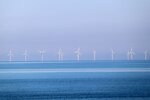06/19/2009
Brazil - Commitment to promoting wind energy
A commitment signed by federal and state authorities in Brazil Thursday was described by the energy minister as a "historic step" towards promoting wind power. The so-called "wind charter" is aimed at developing public policies and setting targets for the production of wind energy, which currently accounts for less than one percent of the power generated in South America’s giant. It also establishes goals for raising funds, formulating public policies and creating incentives for developing wind power, a clean renewable source of energy that is growing 27 percent a year worldwide.
Brazil has the greatest wind power potential in Latin America and the Caribbean, according to experts. The document "is a historic step forward for wind energy in Brazil," Environment Minister Carlos Minc told IPS in a telephone interview. "Today we set goals and outlined financing and regulatory frameworks, and we won’t miss the wind power train again," said the minister from Natal, the capital of the northeastern state of Rio Grande do Norte.
Minc was one of the signatories of the "wind charter" at the end of a two-day National Wind Energy Forum that ended Friday in Natal and was attended by the state energy secretaries, national authorities, legislators and representatives of the business community. The minister announced that the administration of left-wing President Luiz Inácio Lula da Silva planned to gradually eliminate all taxes on wind power-generating equipment.
The first step in that direction was the announcement of the first auction of licenses for developing wind energy, scheduled for Nov. 25. Minc told IPS that his ministry would propose that the government hold such auctions every year, and that the permits be increased from a power generation capacity of 2,000 megawatts, to 3,000 megawatts. The minister said it was "shameful" that a country like Brazil, which has the biggest wind energy potential in the region, produces a mere 200 megawatts of wind power.
The short-term outlook is to increase total wind power generation capacity to 30,000 or 40,000 megawatts, but the potential is much greater than that: around 140,000 megawatts, according to the latest wind atlas. The Brazilian Wind Industry Association, however, estimates the potential at 300,000 megawatts, which according to the association’s president, Lauro Fiuza, represents three times the current capacity of all energy sources in Brazil.
Minc said that as well as creating incentives for clean renewable energy sources like solar and wind power, his ministry has pushed through initiatives like the requirement that coal- and diesel-fired thermal power plants pay the costs of their greenhouse gas emissions with measures like re-planting forests. He also said large hydroelectric projects, currently the main source of energy in this country of 190 million people, now face a much more rigorous environmental permitting process.
Rio Grande do Norte state energy secretary Jean-Paul Prates said the significance of the "wind charter" lies in its detailed timeframe for promoting wind energy through incentives for R&D and by cutting taxes. Prates told IPS that at the start, government subsidies are "inevitable" for stepping up wind energy production. He pointed out that state support was used to encourage development of wind power in Spain, Denmark, the Netherlands, Portugal and "even the United States, which is more free-market-oriented." He added that it is a myth that wind power is more expensive to generate than traditional sources of energy.
The state energy secretary stressed that "wind is free," and that some estimates fail to take into account other costs of traditional energy sources, like pollution and its social and economic consequences. Another common myth, said Prates, is that wind turbines kill wildlife. He said that idea emerged from early wind parks in the U.S. state of California, which were located on bird migration routes and operated with older technology. The newer models have been designed to reduce bird mortality. At any rate, power lines, collisions with trucks, automobiles and buildings, and feral cats are all much bigger killers of birds.
Another misconception discussed by a panel at the National Wind Energy Forum on "myths and truths about wind energy" is that the turbines create "visual pollution," said Prates. Surveys carried out in areas where wind parks have been set up show that they do not bother local residents, because people are aware that they generate electricity and thus provide economic benefits, he said. Because of its strong, constant winds, Rio Grande do Norte on the Atlantic coast in the extreme northeast of Brazil is one of the states with the greatest potential for expanding wind energy. In a conversation with IPS, Governor Wilma de Faria highlighted the efforts made by her state to encourage wind energy production.
The state has two wind parks that generate 53 megawatts. Faria of the Brazilian Socialist Party emphasised that her state alone could generate 22,000 megawatts or more, according to new studies that assess potential in windy areas. Rio Grande do Norte’s aim is to generate 8,000 megawatts of wind energy a year five years from now, by auctioning permits and offering incentives. The state, which is not self-sufficient in energy production, thus hopes to eventually be able to sell surplus electricity to other parts of the country.
According to the United Nations Environment Programme (UNEP), Brazil is the world’s largest renewable energy market, with around 46 percent of the country’s energy coming from renewable sources, which represent 85 percent of its power generation capacity due to its vast hydropower resources and its decades-old ethanol industry. In addition, Brazil accounted for more than 90 percent of new investment in renewable energy in Latin America in 2008, UNEP reported. Furthermore, over 90 percent of new cars run on any proportion of gasoline and sugar cane ethanol, which produces fewer greenhouse gas emissions than fossil fuels.
Despites its steady growth, wind energy is still considered a marginal source of energy, with just one percent of global electricity consumption coming from wind. But in some countries the proportion is much higher: 20 percent in Denmark, 13 percent in Spain, 11 percent in Portugal and nine percent in Italy.
For more information please contact Trevor Sievert at ts@windfair.net
Brazil has the greatest wind power potential in Latin America and the Caribbean, according to experts. The document "is a historic step forward for wind energy in Brazil," Environment Minister Carlos Minc told IPS in a telephone interview. "Today we set goals and outlined financing and regulatory frameworks, and we won’t miss the wind power train again," said the minister from Natal, the capital of the northeastern state of Rio Grande do Norte.
Minc was one of the signatories of the "wind charter" at the end of a two-day National Wind Energy Forum that ended Friday in Natal and was attended by the state energy secretaries, national authorities, legislators and representatives of the business community. The minister announced that the administration of left-wing President Luiz Inácio Lula da Silva planned to gradually eliminate all taxes on wind power-generating equipment.
The first step in that direction was the announcement of the first auction of licenses for developing wind energy, scheduled for Nov. 25. Minc told IPS that his ministry would propose that the government hold such auctions every year, and that the permits be increased from a power generation capacity of 2,000 megawatts, to 3,000 megawatts. The minister said it was "shameful" that a country like Brazil, which has the biggest wind energy potential in the region, produces a mere 200 megawatts of wind power.
The short-term outlook is to increase total wind power generation capacity to 30,000 or 40,000 megawatts, but the potential is much greater than that: around 140,000 megawatts, according to the latest wind atlas. The Brazilian Wind Industry Association, however, estimates the potential at 300,000 megawatts, which according to the association’s president, Lauro Fiuza, represents three times the current capacity of all energy sources in Brazil.
Minc said that as well as creating incentives for clean renewable energy sources like solar and wind power, his ministry has pushed through initiatives like the requirement that coal- and diesel-fired thermal power plants pay the costs of their greenhouse gas emissions with measures like re-planting forests. He also said large hydroelectric projects, currently the main source of energy in this country of 190 million people, now face a much more rigorous environmental permitting process.
Rio Grande do Norte state energy secretary Jean-Paul Prates said the significance of the "wind charter" lies in its detailed timeframe for promoting wind energy through incentives for R&D and by cutting taxes. Prates told IPS that at the start, government subsidies are "inevitable" for stepping up wind energy production. He pointed out that state support was used to encourage development of wind power in Spain, Denmark, the Netherlands, Portugal and "even the United States, which is more free-market-oriented." He added that it is a myth that wind power is more expensive to generate than traditional sources of energy.
The state energy secretary stressed that "wind is free," and that some estimates fail to take into account other costs of traditional energy sources, like pollution and its social and economic consequences. Another common myth, said Prates, is that wind turbines kill wildlife. He said that idea emerged from early wind parks in the U.S. state of California, which were located on bird migration routes and operated with older technology. The newer models have been designed to reduce bird mortality. At any rate, power lines, collisions with trucks, automobiles and buildings, and feral cats are all much bigger killers of birds.
Another misconception discussed by a panel at the National Wind Energy Forum on "myths and truths about wind energy" is that the turbines create "visual pollution," said Prates. Surveys carried out in areas where wind parks have been set up show that they do not bother local residents, because people are aware that they generate electricity and thus provide economic benefits, he said. Because of its strong, constant winds, Rio Grande do Norte on the Atlantic coast in the extreme northeast of Brazil is one of the states with the greatest potential for expanding wind energy. In a conversation with IPS, Governor Wilma de Faria highlighted the efforts made by her state to encourage wind energy production.
The state has two wind parks that generate 53 megawatts. Faria of the Brazilian Socialist Party emphasised that her state alone could generate 22,000 megawatts or more, according to new studies that assess potential in windy areas. Rio Grande do Norte’s aim is to generate 8,000 megawatts of wind energy a year five years from now, by auctioning permits and offering incentives. The state, which is not self-sufficient in energy production, thus hopes to eventually be able to sell surplus electricity to other parts of the country.
According to the United Nations Environment Programme (UNEP), Brazil is the world’s largest renewable energy market, with around 46 percent of the country’s energy coming from renewable sources, which represent 85 percent of its power generation capacity due to its vast hydropower resources and its decades-old ethanol industry. In addition, Brazil accounted for more than 90 percent of new investment in renewable energy in Latin America in 2008, UNEP reported. Furthermore, over 90 percent of new cars run on any proportion of gasoline and sugar cane ethanol, which produces fewer greenhouse gas emissions than fossil fuels.
Despites its steady growth, wind energy is still considered a marginal source of energy, with just one percent of global electricity consumption coming from wind. But in some countries the proportion is much higher: 20 percent in Denmark, 13 percent in Spain, 11 percent in Portugal and nine percent in Italy.
For more information please contact Trevor Sievert at ts@windfair.net
- Source:
- Online editorial www.windfair.net
- Author:
- Posted by: Trevor Sievert Online Editorial Journalist
- Email:
- ts@windfair.net
- Link:
- www.windfair.net/...
- Keywords:
- wind energy, renewable energy, jobs, wind turbine, wind power, wind farm, rotorblade, onshore, offshore


























